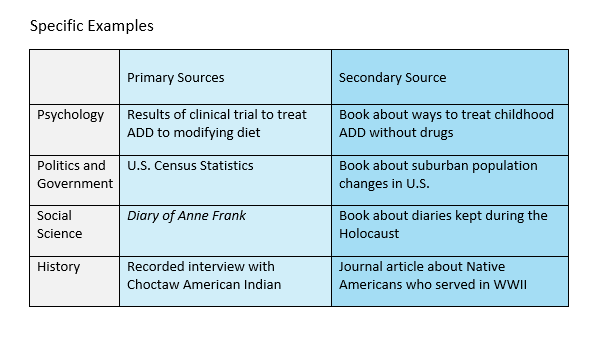
Primary and Secondary Sources of Information
When we conduct research for any academic project, we need to gather information and support statements from various primary and secondary sources. The primary source of information is where you find raw information on a subject from a direct source. Some of the examples of primary sources are interviews, statistical data or artworks. When it comes to collecting information from secondary sources, then it is considered second-hand information. This type of data is usually found in commentaries from other researches or review papers. Some of the examples of secondary sources are journals, articles, or academic books. This type of source can also be defined as the interpretation of primary sources with proper description.
In terms of credibility, primary sources are found to be more reliable and secondary research includes information from both primary and secondary sources.
Primary source
When you research about a person, phenomenon or event, a primary source helps you find information from a direct source. The major difference between a primary and secondary source is that primary sources are the fundamental substance of research and analysis. Now, if you research a topic that has been performed in the past, you will not be able to access the information all by yourself. In that case, you need to refer to primary sources like newspapers or photographs, sources that existed in the past. And suppose the research topic is something related to the present scenario. In that case, the primary sources you are considering could be either qualitative or quantitative, based on the needs and requirements of the researcher. Some of the examples of these data sources would be experiments or interviews.
Suppose you are conducting your research on a history topic, then the examples of primary sources would be interviews, newspapers, magazines, and social media posts. To find data on political topics, examples of primary sources would be government or official documents, legal papers, and court recordings.
Secondary source
When you intend to describe an interpretation or analyze information from a primary source, then it is defined as a secondary source. Some of the common examples of secondary sources are articles, books, documentaries, summaries, workbooks, accounts of artworks, encyclopedias, review papers or essays. While citing a secondary source, the purpose is not to analyze the information source directly; rather, its more about taking a reference from its notion that can help the researcher create their own arguments and statements.
Difference between primary and secondary sources
Here we have provided some questions that can help you differentiate between the primary and secondary sources of research.
Does the information source belong to another researcher like you? Then it is a secondary source. On the other hand, if the sources come directly from its origin, then it is a primary source.
Are you willing to analyze the information source you found? If yes, then it is a primary source. If it’s only about the background statistics, then it is a secondary source.
Does the information source provide original content? Then, obviously, it is a primary source. If the information is taken from a different place, then it is a secondary source.
What are primary sources used for?
In terms of original content, primary sources are the foundation base of every research. These sources help you to:
- Identify new facts and details.
- Provide credible evidence to support your statements and arguments.
- Provide reliable information about the topic.
What are secondary sources used for?
These types of sources are usually used to create the full impression of the subject. You can also use it to refrain from other research materials in your content. These sources allow you to:
- Contrast your thoughts or statements with other researcher’s work.
- Procure more data from primary sources, which was not possible earlier.
- Obtain supplementary information on the subject.
So, this was all about the primary and secondary sources of information and how you can use them for your research. Apart from this, if you need help regarding your academic assignments or papers, feel free to contact our online academic writing services for professional help and guidance.




